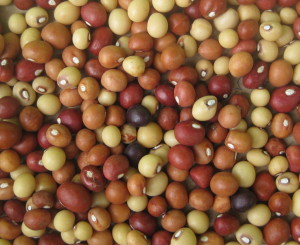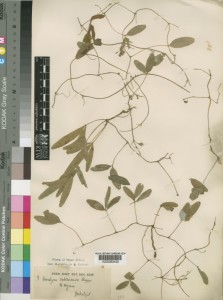Category : News
Published : February 6, 2015 - 10:39 AM
Bambara groundnut (Vigna subterranea) is a creeping annual legume native to the semi-arid areas of Africa. Although it grows best in dry areas with sandy soils, the crop also produces yield in highland regions such as Zambia and Zimbabwe reflecting on its adaptability in a variety of regions. However, damp and humid regions make the crop more susceptible to fungal diseases.
The crops resistance to high temperatures and drought and its ability to fix nitrogen make it a valuable crop and commodity in areas where soil conditions are considered too poor for other crops to grow. The plant grows its most valuable part its fruits under the ground in the soil. As a result the seeds are protected from insect damage which can devastate other crops such as cowpea, common bean and soybean, whose tastiest parts are above ground.
Predominantly grown by women subsistence farmers in areas such as rural North-east Ghana the cultivation allows women to gain access to markets and provide an opportunity for income generation. The engagement of women in Bambara groundnut farming leads to the empowerment of female farmers and is considered extremely valuable as profits can be contributed towards school fees for education as well as purchase high quality cooking ingredients and livestock feed.
The edible seeds produced vary in colour from dark-brown, black, red, cream, and white and are an important source of food security. They are considered a complete food which people can rely on solely for all their nutritional needs. . Eaten fresh or dried, the seeds provide valuable nutrition which boasts averagely 65% carbohydrate, 6.5% fat and 18% protein content. The high protein content makes it an important component of peoples diets that cant afford expensive animal protein.
The produce can be sold freshly shelled, unshelled, dried, and processed. In its processed form groundnut is sold as high-quality cooking oil, flour, and as an ingredient which features in many traditional dishes such as Nkatenkwan a peanut soup, cookies, cakes and sweeties. The crop is also fed to livestock as an important source of protein and the leaves contain rich levels of nitrogen and potassium. In extremely low input areas and areas where there are a range of challenges such as in rural North-east Ghana, groundnuts are considered as a lifesaver during the hungry season and play an important role in local diets.
Bambaras resilience to adverse growing conditions, often in areas where cultivating other crops proves difficult, is an important reason why it has become the focus of crop improvement efforts. Its wild relatives, Vigna subterranean var.spontanea and Vigna hosei, may prove an important source of variation for such improvement efforts Adapting agriculture to climate changes and extreme weather events such as drought, flooding, rise and fall in temperatures relies on the diversity of crops and their wild relatives to develop future varieties that can tolerate and adapt to ever changing climatic conditions.
Story written by: Danielle Haddad
Sources
http://www.fao.org/traditional-crops/bambaragroundnut/en/?utm_source=twitter&utm_medium=social+media&utm_campaign=faoknowledge
http://www.nri.org/news/2013/beliefs-taboos-and-gender-the-case-of-bambara-groundnut-in-malawi
http://www.nda.agric.za/docs/brochures/bambara.pdf

